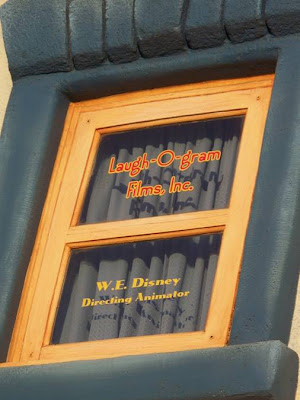


Woven throughout Toontown, in Disneyland, are windows very much like those that overlook the Main Streets of the world. Instead of Imagineers, administrators, and other prolific figures of the Disney Company, these windows onto the world are filled with famous toon citizens, and their respective jobs. Like the fictitious jobs of their true life counterparts, the occupations of the animated world are false, but not altogether unexpected. Catering is provided by the 3 Nephews, Construction from the 3 Little Pigs (demolition falls under the Big Bad Wolf’s domain),
 Jiminy Cricket is the Motivational Speaker, the 101 Dalmatians are the 101st Fire Company, as well as detectives, out door tours, prosthetics, and singing lessons, among others. Yet, the window that tops them all, the window that some might say started it all, is a window that is completely genuine. Tucked away in a quiet corner of Toontown, if their is sucha thing, is the window representing Walt Disney and his company, Laugh-O-gram.
Jiminy Cricket is the Motivational Speaker, the 101 Dalmatians are the 101st Fire Company, as well as detectives, out door tours, prosthetics, and singing lessons, among others. Yet, the window that tops them all, the window that some might say started it all, is a window that is completely genuine. Tucked away in a quiet corner of Toontown, if their is sucha thing, is the window representing Walt Disney and his company, Laugh-O-gram. Laugh-O-gram was started by Walt Disney in 1922 in Kansas City, when Walt was only 20. Walt, along with a few other young animators, including Ub Iwerks, began their work with a retelling of Little Red Riding Hood. With their initial success they were able to find backing in a company named Pictorial Clubs, who immediately sent one-hundred dollars, with the promise of eleven thousand more for a set of six cartoons. With the assurance of a substantial income work began immediately on five other projects: Goldilocks and the Three Bears, Jack and the Beanstalk, Puss in Boots, The Four Musicians of Bremen, and perhaps the project gave the greatest indication of Walt Disney’s future, Cinderella.
Laugh-O-gram was started by Walt Disney in 1922 in Kansas City, when Walt was only 20. Walt, along with a few other young animators, including Ub Iwerks, began their work with a retelling of Little Red Riding Hood. With their initial success they were able to find backing in a company named Pictorial Clubs, who immediately sent one-hundred dollars, with the promise of eleven thousand more for a set of six cartoons. With the assurance of a substantial income work began immediately on five other projects: Goldilocks and the Three Bears, Jack and the Beanstalk, Puss in Boots, The Four Musicians of Bremen, and perhaps the project gave the greatest indication of Walt Disney’s future, Cinderella.Unfortunately, due to legal loopholes, no payment was compulsory until six months after the contracts had been signed. While the films were shipped as they were finished, by the time the six months elapsed, Pictorial Clubs had filed bankruptcy and Laugh-O-grams was left with only the original one-hundred dollar advance. On the brink of bankruptcy himself, Walt Disney attempted to find other projects for shrinking pool of animators, including films like a sing-a-long called Martha and a film about dental health titled Tommy Tucker’s Tooth.
 By this time Walt Disney was living in the studio, using the funds he was receiving to begin another ambitious project. In Alice’s Wonderland, again perhaps foreshadowing Walt’s future, Walt would attempt to cohesively merge a human actor’s (or actress, as the case may be) performance with an animated world created later. Though the project, as well as a number of sequels, would eventually be completed, Walt’s time in Kansas City grew short. With Alice’s Wonderland only partially complete, Walt, following his brother Roy’s solemn advice, accepted that he had failed, filed bankruptcy, and headed west. The rest, as they say, is history.
By this time Walt Disney was living in the studio, using the funds he was receiving to begin another ambitious project. In Alice’s Wonderland, again perhaps foreshadowing Walt’s future, Walt would attempt to cohesively merge a human actor’s (or actress, as the case may be) performance with an animated world created later. Though the project, as well as a number of sequels, would eventually be completed, Walt’s time in Kansas City grew short. With Alice’s Wonderland only partially complete, Walt, following his brother Roy’s solemn advice, accepted that he had failed, filed bankruptcy, and headed west. The rest, as they say, is history.These days, in the world that Walt Disney built, the Laugh-O-gram windows are one of the scant reminders of that time. The Alice shorts are currently available on the Walt Disney Treasure, Disney Rarities. As for the rest of the dreams created at Laugh-O-gram, well, all you have to do is look at your DVD collection, chances are you own a piece of Disney’s imagination and ingenuity, look in a scrapbook or on your wall, you probably have a photograph of a timeless vista he worked to create, or take a moment to think about something Disney, chances are it brings a smile to your face. You can thank Laugh-O-grams for instilling the sense of never give up, or at least a piece of it, that Walt worked so hard to perfect. After all, it was Walt Disney who once said, “You may not realize it when it happens, but a kick in the teeth may be the best thing in the world for you.”
.jpg)



1 comment:
Very nice article.
I haven't seen a lot of coverage of the Disneyland Toontown area in the blog-o-sphere before.
Thanks for sharing?
Post a Comment